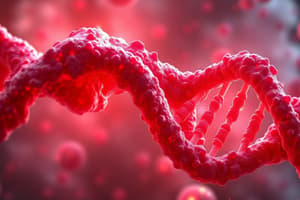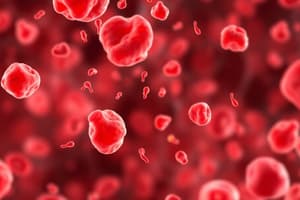Podcast
Questions and Answers
Which of the following best describes the underlying cause of the macrocytosis observed in megaloblastic anemia?
Which of the following best describes the underlying cause of the macrocytosis observed in megaloblastic anemia?
- Increased production of hemoglobin resulting in larger red blood cell size.
- Impaired DNA synthesis causing delayed nuclear maturation relative to cytoplasmic development. (correct)
- Accelerated red blood cell division leading to premature release from the bone marrow.
- Decreased membrane lipids in red blood cells causing them to swell.
In megaloblastic anemia, why does hemoglobin (Hb) synthesis typically remain unaffected despite the presence of impaired DNA synthesis?
In megaloblastic anemia, why does hemoglobin (Hb) synthesis typically remain unaffected despite the presence of impaired DNA synthesis?
- RNA strands, essential for hemoglobin production, are not directly impacted by the DNA synthesis impairment. (correct)
- Megaloblastic anemia primarily affects erythroid precursors and does not impact mature red blood cells responsible for hemoglobin production.
- The excess iron accumulation in bone marrow compensates for any potential disruptions in hemoglobin production.
- Hemoglobin synthesis relies on mitochondrial DNA, which is not affected in megaloblastic anemia.
What cellular characteristic distinguishes megaloblastic anemia from other types of macrocytic anemias when observing bone marrow erythrocyte precursors?
What cellular characteristic distinguishes megaloblastic anemia from other types of macrocytic anemias when observing bone marrow erythrocyte precursors?
- Smaller than normal nucleus
- Normal cytoplasmic development (correct)
- Reduced hemoglobin content
- Decreased overall cell size
Which of the following mechanisms is primarily responsible for the macrocytosis observed in non-megaloblastic anemia?
Which of the following mechanisms is primarily responsible for the macrocytosis observed in non-megaloblastic anemia?
A patient presents with macrocytic anemia, reticulocytopenia and normal MCHC. What other hematological findings would most likely support a diagnosis of macrocytic anemia?
A patient presents with macrocytic anemia, reticulocytopenia and normal MCHC. What other hematological findings would most likely support a diagnosis of macrocytic anemia?
Which characteristic is commonly associated with macrocytic anemia?
Which characteristic is commonly associated with macrocytic anemia?
A patient's blood smear shows several macrocytes. Which condition is least likely to be the cause of the macrocytosis?
A patient's blood smear shows several macrocytes. Which condition is least likely to be the cause of the macrocytosis?
What is the most direct consequence of impaired DNA synthesis in megaloblastic erythropoiesis regarding cell cycle progression?
What is the most direct consequence of impaired DNA synthesis in megaloblastic erythropoiesis regarding cell cycle progression?
What underlying mechanism primarily contributes to the development of atrophy in the gastric mucosa among individuals with pernicious anemia?
What underlying mechanism primarily contributes to the development of atrophy in the gastric mucosa among individuals with pernicious anemia?
A patient presents with macrocytic anemia and a history of Crohn's disease. Which of the following mechanisms is the most likely cause of their anemia?
A patient presents with macrocytic anemia and a history of Crohn's disease. Which of the following mechanisms is the most likely cause of their anemia?
Why might alcoholism cause macrocytic anemia?
Why might alcoholism cause macrocytic anemia?
How does methotrexate contribute to folic acid deficiency?
How does methotrexate contribute to folic acid deficiency?
What is the primary distinction between macrocytes seen in megaloblastic anemia versus those in non-megaloblastic anemia?
What is the primary distinction between macrocytes seen in megaloblastic anemia versus those in non-megaloblastic anemia?
Which of the following findings would be least likely in a patient with non-megaloblastic macrocytic anemia?
Which of the following findings would be least likely in a patient with non-megaloblastic macrocytic anemia?
What hematological response is expected when stimulated erythropoiesis leads to macrocytosis, assuming adequate iron stores?
What hematological response is expected when stimulated erythropoiesis leads to macrocytosis, assuming adequate iron stores?
A patient with a history of long-term anticoagulant use develops macrocytic anemia. What is the most plausible mechanism linking anticoagulant therapy to this hematological complication?
A patient with a history of long-term anticoagulant use develops macrocytic anemia. What is the most plausible mechanism linking anticoagulant therapy to this hematological complication?
In megaloblastic anemia, what is the primary mechanism by which a deficiency of vitamin B12 and folic acid leads to impaired DNA replication?
In megaloblastic anemia, what is the primary mechanism by which a deficiency of vitamin B12 and folic acid leads to impaired DNA replication?
A patient presents with macrocytic anemia, neurological symptoms, and laboratory findings indicating hypersegmented neutrophils and elevated levels of methylmalonic acid. Which of the following underlying mechanisms is MOST likely responsible for these findings?
A patient presents with macrocytic anemia, neurological symptoms, and laboratory findings indicating hypersegmented neutrophils and elevated levels of methylmalonic acid. Which of the following underlying mechanisms is MOST likely responsible for these findings?
A patient with a history of gastrectomy presents with macrocytic anemia. Which of the following mechanisms is the MOST likely cause of their anemia?
A patient with a history of gastrectomy presents with macrocytic anemia. Which of the following mechanisms is the MOST likely cause of their anemia?
Following a hemigastrectomy, a patient develops megaloblastic anemia. Which of the following mechanisms BEST explains the link between the hemigastrectomy and the onset of anemia?
Following a hemigastrectomy, a patient develops megaloblastic anemia. Which of the following mechanisms BEST explains the link between the hemigastrectomy and the onset of anemia?
A patient diagnosed with macrocytic anemia presents with fatigue, shortness of breath, and glossitis. Peripheral blood smear analysis reveals oval macrocytes, hypersegmented neutrophils, and Howell-Jolly bodies. Which of the following pathophysiological processes BEST explains the presence of Howell-Jolly bodies in this patient's blood smear?
A patient diagnosed with macrocytic anemia presents with fatigue, shortness of breath, and glossitis. Peripheral blood smear analysis reveals oval macrocytes, hypersegmented neutrophils, and Howell-Jolly bodies. Which of the following pathophysiological processes BEST explains the presence of Howell-Jolly bodies in this patient's blood smear?
Which of the following laboratory findings would be LEAST expected in a patient with macrocytic anemia due to vitamin B12 deficiency?
Which of the following laboratory findings would be LEAST expected in a patient with macrocytic anemia due to vitamin B12 deficiency?
A patient is diagnosed with macrocytic anemia secondary to folate deficiency. Beyond dietary insufficiency, which condition is MOST likely to directly interfere with folate absorption in the small intestine?
A patient is diagnosed with macrocytic anemia secondary to folate deficiency. Beyond dietary insufficiency, which condition is MOST likely to directly interfere with folate absorption in the small intestine?
In the context of macrocytic anemia, what is the MOST direct consequence of impaired DNA synthesis on developing blood cells within the bone marrow?
In the context of macrocytic anemia, what is the MOST direct consequence of impaired DNA synthesis on developing blood cells within the bone marrow?
Flashcards
Macrocytic Anaemia
Macrocytic Anaemia
Anaemia characterized by abnormally large red blood cells, MCV > 100 fL, with normal haemoglobin content.
Megaloblastic Anaemia
Megaloblastic Anaemia
Characterized by delayed nuclear development, leading to abnormal RBC maturation in the bone marrow.
Causes of Megaloblastic Anaemia
Causes of Megaloblastic Anaemia
Vitamin B12 or folate deficiencies or drugs interfering with DNA metabolism.
Non-Megaloblastic Macrocytic Anaemia
Non-Megaloblastic Macrocytic Anaemia
Signup and view all the flashcards
Megaloblast
Megaloblast
Signup and view all the flashcards
Megaloblastic Anaemia Cause
Megaloblastic Anaemia Cause
Signup and view all the flashcards
Megaloblast Characteristics
Megaloblast Characteristics
Signup and view all the flashcards
Macrocytic Anemia - Lab Findings
Macrocytic Anemia - Lab Findings
Signup and view all the flashcards
Granulocyte Abnormality
Granulocyte Abnormality
Signup and view all the flashcards
Megakaryocyte Abnormality
Megakaryocyte Abnormality
Signup and view all the flashcards
Macrocytic Anemia Triad
Macrocytic Anemia Triad
Signup and view all the flashcards
Megaloblastic Anemia Mechanism
Megaloblastic Anemia Mechanism
Signup and view all the flashcards
Intrinsic Factor (IF)
Intrinsic Factor (IF)
Signup and view all the flashcards
Causes of Macrocytic Anemia
Causes of Macrocytic Anemia
Signup and view all the flashcards
Pernicious Anemia
Pernicious Anemia
Signup and view all the flashcards
Autoimmune Atrophic Gastritis
Autoimmune Atrophic Gastritis
Signup and view all the flashcards
Schilling Test
Schilling Test
Signup and view all the flashcards
Folic Acid Deficiency (Diet)
Folic Acid Deficiency (Diet)
Signup and view all the flashcards
Folic Acid Deficiency (Malabsorption)
Folic Acid Deficiency (Malabsorption)
Signup and view all the flashcards
Folic Acid Deficiency (Increased Need)
Folic Acid Deficiency (Increased Need)
Signup and view all the flashcards
Folic Acid Deficiency (Drugs)
Folic Acid Deficiency (Drugs)
Signup and view all the flashcards
Non-Megaloblastic Anemia
Non-Megaloblastic Anemia
Signup and view all the flashcards
Stimulated Erythropoiesis
Stimulated Erythropoiesis
Signup and view all the flashcards
Study Notes
- Macrocytic anemia is characterized by large RBCs with normal hemoglobin content.
- Large erythrocytes characterize it, with a Mean Corpuscular Volume (MCV) greater than 100.
- Macrocytic anemia is classified into megaloblastic and non-megaloblastic types.
Megaloblastic Anemia
- Results in postponed nuclear development, leading to abnormal RBC maturation in the bone marrow, resulting in macrocytes.
- It is due to abnormal DNA synthesis, usually from vitamin B12 or folate deficiencies, and drugs that interfere with DNA metabolism.
- Drugs that interfere with DNA metabolism and inherited disorders that affect DNA synthesis can cause megaloblastic anemia.
- "Megaloblast" is a large, abnormal marrow erythrocyte precursor.
- It is a group of disorders with defective nuclear maturation caused by impaired DNA synthesis.
- Impairment results from a substitution in the nucleic acid chain, causing DNA replication to fragment.
- Nuclear replication slows down or stops, causing maturation delays and prolonging the premitotic interval.
- Cellular observation includes a large nucleus, normal cytoplasm development, and normal hemoglobin synthesis because RNA strands are unaffected.
Macrocytic Anemia Characteristics
- The anemia is macrocytic and normochromic.
- Increased Mean Corpuscular Hemoglobin (MCH) is due to the large cell volume.
- Normal Mean Corpuscular Hemoglobin Concentration (MCHC) is observed.
- Red Blood Cell (RBC) count and Hemoglobin (HGB) are decreased.
- Reticulocytopenia is present.
- Granulocytes and thrombocytes are affected.
- Granulocytes are hypersegmented due to impaired DNA synthesis.
- Abnormal megakaryocytes result in thrombocytopenia.
- It has a triad of oval macrocytes.
- Howell-Jolly bodies are DNA fragments.
- There are hypersegmented neutrophils.
- Anisocytosis is moderate.
- Poikilocytosis is present.
- Nucleated Red Blood Cells (nRBC) and Cabot rings are observed.
- RBCs are fragile, with a shortened lifespan, and die in the bone marrow, causing increased Lactate Dehydrogenase (LDH).
Causes of Megaloblastic Anemia
- Vitamin B12 deficiency.
- Folate deficiency.
- Drugs.
- Myelodysplastic syndromes.
- Acute leukemia.
- The primary defect is DNA replication depletion of thymidine triphosphate (TTP), which retards nuclear maturation.
- Vitamin B12 and folic acid are two main reasons behind TTP depletion.
- Vitamin B12 deficiency stems from a lack of intrinsic factor (IF).
- Intrinsic factor binds vitamin B12, enabling its absorption in the intestines.
- IF is released by cells in the stomach.
- When the stomach doesn't produce sufficient intrinsic factor, the intestine cannot properly absorb vitamin B12.
- Inadequate dietary intake.
Malabsorption Factors
- Pernicious anemia, caused by gastric parietal cell atrophy, reduces intrinsic factor (IF) secretion.
- Intrinsic factor is necessary for vitamin B12 absorption.
- Atrophy results from immune destruction of the acid-secreting portion of the gastric mucosa.
- Onset typically occurs after age 40, primarily affecting women of Northern European backgrounds.
- Neurologic problems.
- Schilling test is used for diagnosis.
- Gastrectomy.
- Blind loop syndrome.
- Fish tapeworm.
- Helicobacter pylori
Folic Acid Deficiency
- Inadequate Dietary input.
- Malabsorption which may stem from diseases of the upper small intestine.
- Increased need such as pregnancy, hemolytic anemia, or leukemia.
- Drugs like oral contraceptives, alcohol, and anticoagulant drugs.
- Ileitis/Crohn's disease.
- Tropical sprue.
- Blind loop syndrome.
- Nontropical sprue, including gluten-sensitive enteropathy and childhood celiac disease.
Folic Acid Deficiency Cause by Drugs
- Methotrexate (chemotherapy drug and folate antagonist).
- Alcohol.
- Oral contraceptives.
- Long-term anticoagulant drugs.
- Chronic liver disease.
- Alcoholism, where alcohol has a toxic effect on RBCs.
- Stimulated Erythropoiesis.
- Specifically in Newborns.
- Ethanol has a toxic influence on precursor cells.
- Red cells become macrocytic.
- Enhanced EPO, adequate iron, the release of stress reticulocytes.
Non-Megaloblastic Anemia
- DNA synthesis is not impaired.
- MCV does not increase as much as in megaloblastic anemia.
- Macrocytes are round, NOT oval.
- No hypersegmented neutrophils are present.
- Leukocytes and platelets are normal.
- Jaundice, glossitis, and neuropathy are absent.
Studying That Suits You
Use AI to generate personalized quizzes and flashcards to suit your learning preferences.



